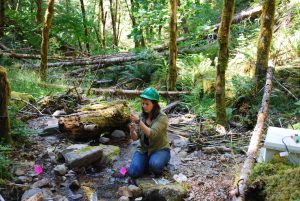12 May 2016
Small headwater streams export surprising amounts of carbon out of Pacific Northwest forests
Posted by edeatrick
By Nicolas Houtman
Scientists have tracked a higher-than-expected amount of carbon flowing out of a Pacific Northwest forest from month to month through a small headwater stream, suggesting that forested watersheds may not store quite as much carbon as previously thought.
In a paper published in the Journal of Geophysical Research — Biogeosciences, a journal of the American Geophysical Union, a team led by Alba Argerich, an assistant professor of research in the College of Forestry at Oregon State University in Corvallis, Ore., reported that a small headwater stream in the Cascades exports, on average, about 6 percent of what forests absorb from the atmosphere and store.

Alba Argerich, assistant research professor at Oregon State University, collects water samples in a headwater stream in Watershed 1 at the H.J. Andrews Experimental Forest.
Credit: US Forest Service
“Although we have a good understanding of the general global carbon cycle, there are still some details we haven’t quantified well,” Argerich said. “One of them is how carbon is stored and exported in small streams. Streams of this size drain three-quarters of the landscape, and when you add up their total influence, they may make quite a difference to the carbon budget.
“Our work suggests that we may be underestimating their influence on carbon dynamics,” she added.
In the past, researchers have generally ignored the role of small streams in the carbon cycle. As a result, a lack of data has prevented scientists from including these streams in computer models. The study by Argerich and her colleagues is one of the most detailed assessments yet of carbon exports in streams.
It was thought that most carbon is exported from streams as dissolved and particulate matter travelling downstream. However, Argerich and her team have shown that more than 25 percent of the carbon leaving streams goes into the atmosphere.
“What we’re seeing is that these small streams export quite a bit of carbon, which we didn’t expect,” Argerich said. “A lot of it goes downstream, but some of it is in the form of carbon dioxide going into the atmosphere.”
Carbon is a critical element in the science of climate change, and the Pacific Northwest has some of the highest carbon storage of any forests in the world. Since streams represent a “leak” of carbon out of the forest, efforts to measure carbon stored in these systems should also account for carbon exported and lost by streams, said Roy Haggerty, co-author and interim dean of the College of Earth, Ocean, and Atmospheric Sciences at Oregon State.
The study was conducted by a collaborative team including Oregon State faculty and graduate students as well as scientists in the Pacific Northwest Research Station of the U.S. Forest Service. They analyzed data collected from 2004 to 2013 in a 50-year old second-growth forest at the H.J. Andrews Experimental Forest in the Cascades east of Eugene, where researchers monitor many forms of carbon.
Carbon flow in small streams has a distinct seasonal pattern. Like an exhaled breath lasting six months or more, the amount of carbon carried downstream starts to increase as rains arrive in the fall. By January, the carbon flowing out of small watersheds typically reaches a peak and then starts to decline. As water levels drop during the summer, little carbon moves out of the forests in streams, mostly through export to the atmosphere.
In general, carbon moves out of the forest in multiple forms — bits of leaves, seeds, branches and other detritus — as well as dissolved in stream water, carried in sediment and pumped back into the air as carbon dioxide gas. Altogether, the amount of carbon from small streams in the Pacific Northwest is similar to the average exported by large rivers globally, said Argerich.
Funding for the research was provided by the National Science Foundation’s Long-Term Ecological Research program and the U.S. Forest Service Pacific Northwest Research Station.
—Nicolas Houtman is the assistant director of research communications at Oregon State University. This post originally appeared as a news release on the OSU College of Forestry website.


 GeoSpace is a blog on Earth and space science, managed by AGU’s Public Information staff. The blog features posts by AGU writers and guest contributors on all sorts of relevant science topics, but with a focus on new research and geo and space sciences-related stories that are currently in the news.
GeoSpace is a blog on Earth and space science, managed by AGU’s Public Information staff. The blog features posts by AGU writers and guest contributors on all sorts of relevant science topics, but with a focus on new research and geo and space sciences-related stories that are currently in the news.